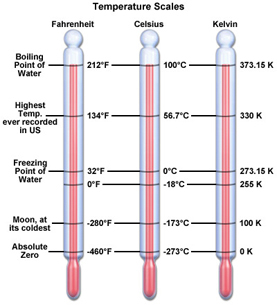
The Celsius and Fahrenheit scales were both built around water, either the freezing point, the boiling point or some combination of water and a chemical. The Kelvin temperature scale is used by scientists because they wanted a temperature scale where zero reflects the complete absence of thermal energy.
As you get to lower and lower temperatures, there are less and less vibrations in the material to provide these thermal excitations. And at absolute zero, or zero Kelvin, there is no longer any thermal energy available. The low-temperature facility here, the Millikelvin Facility, has systems that can get all the way down to about 7.5 millikelvin, or 7.5 thousandths of a degree above absolute zero. At the MagLab's High B/T Facility, temperatures can reach down to 0.004 Kelvin - some of the coldest ever made on Earth! Many quantum mechanical properties are washed out by the thermal agitation that occurs in materials. So by cooling these materials to very low temperatures, we can actually observe the quantum mechanical properties which we just cannot observe at the temperature that we live at every day, at 300 Kelvin.
Learn more about the cool science researchers do at super low temperatures.


